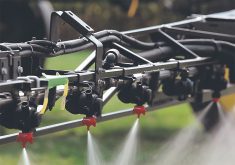It’s time to wean foals and the simultaneous loss of mother and milk can be stressful on the young animals.
“At that age they are just starting to develop their own immunity and the immunity they got from their mother’s colostrum is wearing off,” said Claire Card at the Western College of Veterinary Medicine in Saskatoon.
“If they happen to be stressed at the time they are exposed, then they are more susceptible to getting infections.”
Stress related diseases are usually viral: upper respiratory infections; equine influenza and equine herpes.
Read Also

University of Manitoba hires potato researcher
A new research chair position at the University of Manitoba will tackle sustainability in the potato industry.
Card said while young horses aren’t getting a lot of nutrition from their mothers by six months of age, they are still getting a lot of companionship. Stress can be reduced by placing the animals so they can see or touch each other, but physically are separated.
Jim Graham, livestock agrologist with Saskatchewan Agriculture in Swift Current, said there are two options when weaning.
“Separate the mare and the colt, but leave them next to each other in separate pens, sturdy pens,” he said. “Or the cold turkey option, in which you take the colt away from the mare, out of sight, but provide another companion for the colt, to reduce the stress of separation from the mother.”
He recommended walking out among the foals in the pen, which helps calm them and gets them used to people. A pen or corral is better than a stall and should be sturdy because the foal may try to get out or reunite with the mother.
“When the colt is first weaned it’s going to walk a lot looking for the mother. The colt may walk for three to four days,” said Graham.
He recommended setting good quality hay around the pen so foals will grab a mouthful when walking by and keep up their nutrition.
“Remember the colt is not used to eating by itself.”
Depending on what water source it had in the pasture with its mother, provide water in a bowl, trough or pen. Good, clean water will attract it, said Graham.
He suggested waiting four to five days after the foal has been weaned before feeding oats and grain, but said hay, crested wheat grass or brome and a bit of alfalfa are fine.
Graham said to wait a week or so before adding minerals and vitamins to the foal’s feed. He finds a dry mineral for horses is best, but said some people use a liquid with molasses in it, which may help get the young animal onto grain.
“And I wouldn’t feed a whole lot of grain at first, perhaps only one or two pounds a day. Increase it gradually.”
When worming foals, Graham said to wait until they are well established on feed. There are two types of wormer that can be used: a paste or liquid that is put into the mouth or pellets that can be added to feed.
Card said mixing groups of horses or placing weaned foals with a new group of unfamiliar animals is a big social stress, but this rarely happens with on-farm weaning.
“Most of the time weaning is done on the farm and the animals aren’t moved around and their social groups not mixed a lot. They do just fine. Usually there’s very little illness associated with it.
“It’s when they’re separated, maybe transported to a new location or put in with a lot of other animals they aren’t familiar with that somebody starts to get sick and then it goes through the group very quickly.”














